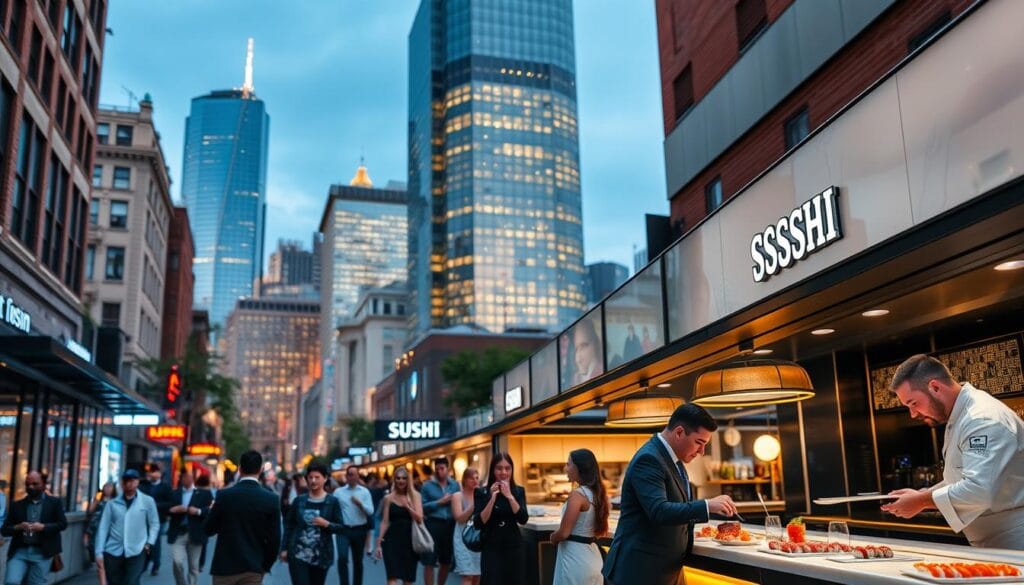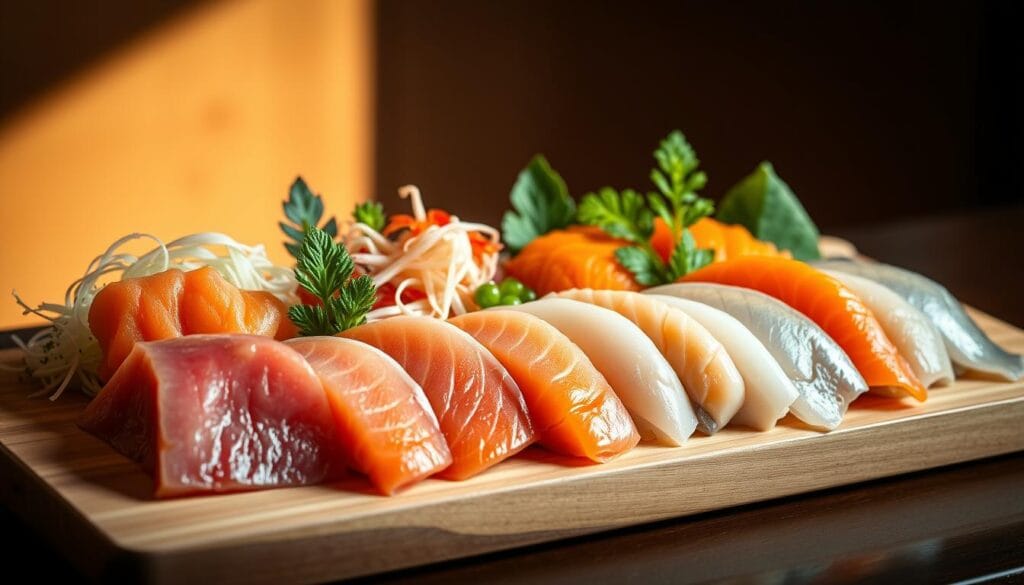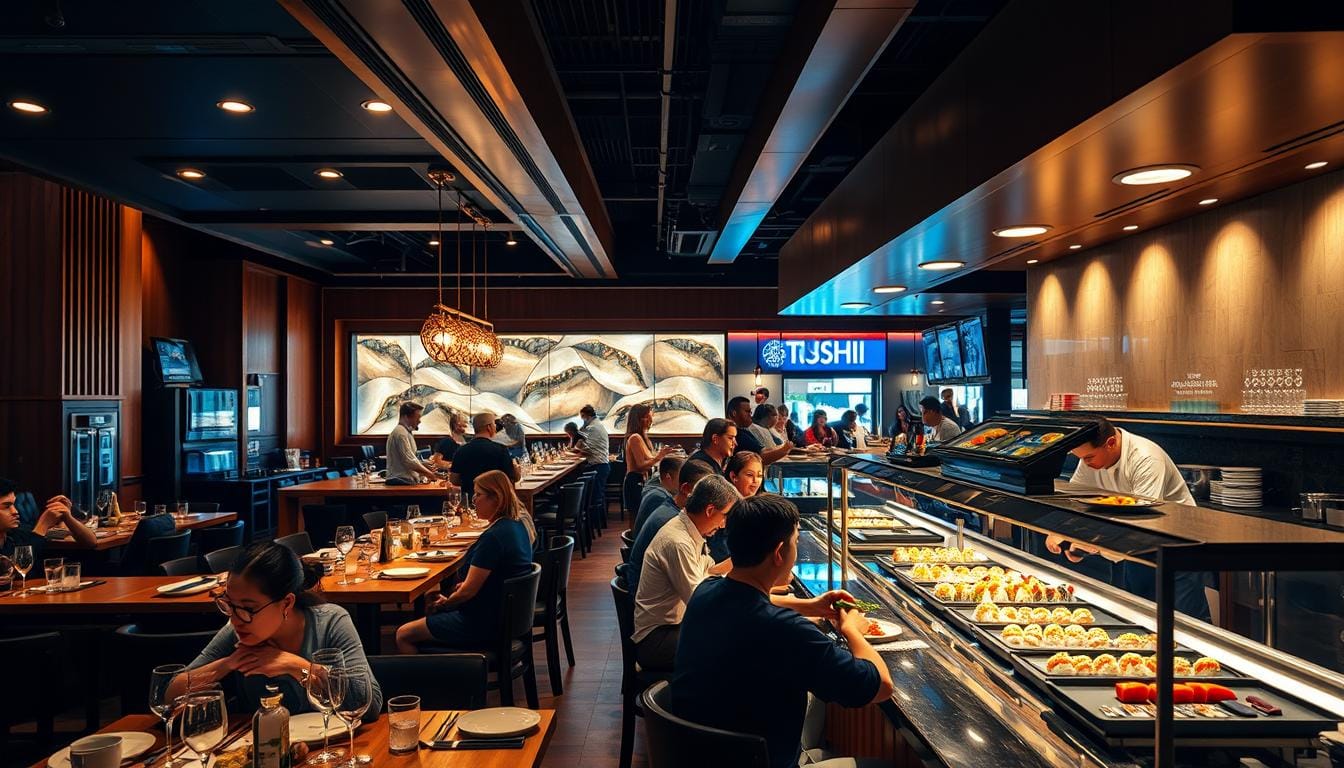The first time I tasted authentic sushi, it was like discovering a culinary symphony. Each delicate piece transformed my understanding of food. It showed me a perfect balance of flavor, technique, and artistry.
Table of Contents
St. Petersburg offers an incredible array of sushi house destinations. You can find everything from authentic Japanese preparations at Sushi Sho Rexley to creative fusion rolls at Rain Japanese Sushi Bar & Thai. There’s a remarkable diversity of sushi styles waiting to be explored.
Whether you’re a seasoned sushi enthusiast or a curious newcomer, these best sushi restaurants provide something extraordinary. Each establishment brings its own personality. Whether it’s the refined modern space of Ahi Sushi or the vibrant atmosphere of Good Fortune, there’s something for everyone.
Key Takeaways
- St. Petersburg hosts diverse sushi restaurant options
- Restaurants range from traditional to fusion styles
- Fresh ingredients define exceptional sushi experiences
- Multiple dining environments to suit different preferences
- Unique rolls and specialties available across locations
Understanding Modern Sushi Restaurant Culture
Sushi has grown from a traditional Japanese dish to a lively food experience loved by many in the U.S. As you dive into the world of sushi, you’ll find a mix of flavors, techniques, and new ideas that change how we eat.
The world of sushi has changed a lot. It now combines old Japanese ways with new cooking ideas. You’ll find different sushi styles and fusion dishes that make dining exciting and new.
Evolution of Sushi in American Dining
American sushi places have changed a lot. They use local foods and ideas from around the world. Some big changes include:
- Introduction of fusion rolls like California Roll
- Incorporation of local seafood and regional ingredients
- Emergence of creative presentation techniques
- Expansion of sushi styles to suit diverse palates
Different Types of Sushi Establishments
Today, you can find many kinds of sushi places. From casual spots to fancy omakase counters, each offers something special:
- Casual neighborhood sushi bars
- High-end traditional Japanese restaurants
- Fusion sushi restaurants
- Interactive chef’s counter experiences
What Makes a Great Sushi Experience
A great sushi meal has many parts. Top sushi places focus on:
- Freshest possible seafood
- Skilled chef preparation
- Balanced flavor profiles
- Authentic presentation techniques
Whether you love sushi or are just starting, exploring sushi opens a world of flavors and experiences. It’s more than just eating food.
Finding Premium Sushi House Locations
Finding the perfect sushi bar near you is all about research and insider tips. Your Japanese dining adventure begins with picking the right spot. Look for a place that offers real sushi, top-notch quality, and a great atmosphere.
When looking for a premium sushi house, keep these key points in mind:
- Location demographics and cultural preferences
- Restaurant visibility and foot traffic
- Chef’s expertise and preparation methods
- Ingredient sourcing and freshness
Digital tools are your best friends in finding great sushi spots. Yelp and Google Maps offer detailed reviews and ratings. They help you find the best sushi places in your area.
| Search Criteria | What to Look For |
|---|---|
| Chef Expertise | Open kitchen concept, chef preparation in view |
| Ingredient Quality | Locally sourced, seasonal seafood |
| Dining Style | Omakase options, traditional preparation |
Pro tip: Visit sushi restaurants during busy times for the freshest ingredients and best dining. Places like Sugarfish and Sushi Yasuda are known for their top sushi.
The best sushi bars turn eating into a journey of flavors.
Essential Elements of Authentic Japanese Dining
Exploring authentic sushi is more than just eating. It’s a deep dive into precision, tradition, and top-notch ingredients. Your adventure into fresh sushi rolls starts with the small details that make a dish unforgettable.
Traditional vs Contemporary Sushi Preparation
Sushi making is a mix of old ways and new ideas. Traditional methods focus on:
- Hand-crafted rolls with sharp knife skills
- Keeping ingredients simple
- Valuing each ingredient’s natural taste
“Sushi is an art form that requires dedication, skill, and profound respect for ingredients.” – Chef Masahiro Tanaka
The Role of the Sushi Chef
A sushi chef is not just a cook. They are artists who spend years perfecting their craft. Their tasks include:
- Picking the best fish
- Getting the rice just right
- Making dishes look beautiful
- Keeping food safe
Quality of Fish and Ingredients
Good sushi needs the best ingredients. Important parts are:
| Ingredient | Importance |
|---|---|
| Sushi Rice | Perfectly seasoned and textured foundation |
| Fresh Fish | Premium, sustainably sourced seafood |
| Nori | High-quality seaweed for optimal flavor |
Choosing a restaurant that values ingredient quality makes for a memorable meal.
Popular Sushi Styles and Specialties
Exploring a top sushi place opens up a world of sushi styles. You’ll find fresh sushi rolls in many exciting variations. These cater to different tastes and preferences.
Let’s look at the most popular sushi types you might find:
- Nigiri: Hand-pressed rice topped with fresh seafood like tuna, salmon, or eel
- Maki Rolls: Traditional rolled sushi with rice and fillings wrapped in seaweed
- Uramaki: Inside-out rolls with rice on the exterior, perfect for creative presentations
- Temaki: Cone-shaped hand rolls filled with various ingredients
- Chirashi: Sushi rice bowl topped with an assortment of sashimi
Each style offers a unique culinary experience. Nigiri highlights the pure flavor of high-quality fish. Maki rolls let you enjoy complex flavor combinations. Temaki is a fun, handheld option for casual dining.
At a top sushi place, chefs often create signature rolls. They blend traditional techniques with innovative ingredients. You might find rolls with truffle-infused fish or tropical fruit garnishes. These add a new twist to the classic sushi experience.
Pro tip: Don’t be afraid to ask your sushi chef about their specialty rolls or recommendations!
The Art of Omakase Dining Experience
Dive into the pinnacle of Japanese dining with omakase. It’s a culinary journey that turns your meal into an extraordinary adventure. This traditional approach to sushi dining lets skilled chefs show their artistry through a carefully curated selection of dishes.
Omakase means “I’ll leave it up to you”. It’s the ultimate trust between diner and chef in top sushi restaurants. It started in Japan’s Edo period, highlighting the chef’s expertise and creativity.
What to Expect from an Omakase Menu
When you choose an omakase experience, get ready for a culinary journey. It usually includes:
- 10-20 meticulously prepared courses
- Fresh, seasonal ingredients
- Sushi, sashimi, and innovative Japanese dishes
- Interactive dining with chef-guided presentation
Price Points and Value
Omakase experiences vary in price, from moderately priced to luxurious. Costs reflect the quality of ingredients and the chef’s expertise. Prices range from $100-$500 per person, based on the restaurant’s reputation and location.
“Omakase is not just a meal, it’s a culinary performance that engages all your senses.” – Renowned Sushi Chef
Reservation Tips and Etiquette
To have a smooth omakase experience, follow these tips:
- Book reservations well in advance
- Arrive on time
- Be open to trying new flavors
- Engage with the chef respectfully
- Avoid custom requests that disrupt the chef’s carefully planned menu
An authentic omakase dining experience is more than just food. It’s a peek into Japanese culinary tradition and the chef’s personal artistic expression.
Top-Rated Sushi Spots in Metropolitan Areas
Looking for the best sushi in big cities is a fun food adventure. Boston and Cambridge are surprising places for amazing sushi. They will make your taste buds happy.

Let’s check out some top sushi places that are changing Japanese food:
- O Ya: A fancy spot in the Leather District, famous for dishes like fried Kumamoto oyster with squid-ink foam
- Uni: Offers a fancy 18-course tasting menu with dishes like duck breast in a smoke-filled cloche
- 311 Omakase: The top place in South End, with an 18-course menu made by a chef from Masa restaurant
These sushi restaurants are all unique. They mix old ways with new ideas, showing the wide range of Japanese food.
| Restaurant | Location | Menu Highlight | Price Range |
|---|---|---|---|
| O Ya | Leather District | Foie gras nigiri | $$$ |
| Uni | Cambridge | 18-course tasting menu | $$$$ |
| 311 Omakase | South End | 18-course omakase | $$$ |
Whether you love sushi or just want to try something new, these cities offer a special dining experience. It’s more than just a meal; it’s a journey through Japanese food made by experts.
Budget-Friendly Yet High-Quality Options
Finding tasty sushi doesn’t have to cost a lot. Many sushi houses offer great value without sacrificing quality. Whether you’re looking for a sushi bar near you or want to save money, there are smart ways to enjoy top-notch Japanese food without spending too much.
Happy Hour Specials
Happy hour is a treasure trove for sushi fans. Many sushi bars give big discounts during slow times. You can find:
- Discounted rolls at 30-50% off regular prices
- Reduced price appetizers and small plates
- Drink specials that pair well with sushi
Lunch vs Dinner Pricing
Choosing the right time to eat sushi can save you a lot. Lunch menus usually offer incredible value compared to dinner. Look for:
- Lunch combinations starting at $12-$15
- Smaller portion sizes at lower rates
- Fixed-price lunch sets with several items
Best Value Combinations
Some sushi bars have special deals that make your meal more worth it. Keep an eye out for:
- Combo platters with mixed roll selections
- Prix fixe menus during certain hours
- Loyalty programs with cumulative discounts
“Great sushi isn’t about spending the most money, but finding the right balance of quality and affordability.” – Local Sushi Chef
Pro tip: Follow your favorite local sushi house on social media. You’ll find exclusive deals and last-minute specials that let you enjoy premium sushi without overspending.
Ambiance and Dining Environment Considerations
Choosing a top sushi place is more than just the food. It’s about the whole experience. The dining environment is key to a great Japanese meal.
The best sushi spots have a few important things:
- Lighting that creates an intimate mood
- Carefully curated background music
- Thoughtful interior design
- Attentive and welcoming staff
Designers know ambiance is crucial. Soft, warm lighting makes you relax. Comfortable seating and privacy are also important. Top sushi places focus on these details.
| Ambiance Element | Impact on Dining Experience |
|---|---|
| Lighting | Creates emotional atmosphere |
| Decor | Reflects restaurant’s cultural authenticity |
| Seating | Ensures guest comfort |
| Staff Interaction | Enhances overall experience |
Modern sushi places use tech to improve your visit. Digital bookings, QR menus, and smooth service make dining better. It’s both old and new.
Think about the atmosphere when picking your sushi spot. A great Japanese meal is more than food. It’s a full sensory experience that you’ll remember.
Fresh Fish Selection and Seasonal Specialties
Exploring authentic sushi cuisine means understanding the art of seasonal fish selection. Your dining experience transforms with each changing season. This brings unique flavors and textures to fresh sushi rolls.

Understanding Sushi Grade Fish
Sushi grade fish is the highest quality seafood available. Chefs carefully select fish based on several critical factors:
- Freshness and origin
- Fat content and texture
- Sustainable fishing practices
- Handling and storage techniques
Winter Sushi Specialty Selections
Winter brings extraordinary seafood options that elevate your authentic sushi cuisine experience. Here are top winter selections:
| Fish Type | Region | Characteristics |
|---|---|---|
| Kanburi (Winter Yellowtail) | Japan Sea, Toyama Bay | Sweet, buttery with fatty texture |
| Kinmedai (Golden Eye Snapper) | Boso Peninsula | Sweet, tender flesh with aromatic skin |
| Ankimo (Monkfish Liver) | Coastal Japan | Smooth texture, deep savory flavor |
Seasonal Menu Transformations
Top sushi restaurants adapt their menus to showcase fresh sushi rolls that capture the essence of each season. Winter specialties often feature richer, more robust flavors compared to lighter summer offerings.
Seasonal ingredients tell a story of local maritime traditions and culinary expertise.
Delivery and Takeout Services
Craving sushi but can’t make it to your favorite sushi house? Modern delivery services have changed how we enjoy Japanese cuisine. Now, you can get restaurant-quality meals delivered right to your door.
When picking a sushi delivery service, think about these important points:
- Delivery area within 1 mile
- How long it takes to get your food (usually 1.5 hours)
- Options for contact-free delivery
- How well the food is packaged
- How the food looks and stays hot
Platforms like Grubhub and ChowNow have made a big difference for sushi restaurants. They help restaurants reach more customers and offer big benefits:
- More chances to sell food (up to 35% more)
- Lower costs for restaurants
- More convenience for customers
But, there are some challenges with sushi delivery. Some issues include:
- Orders sometimes get mixed up
- Food might not stay at the right temperature
- Portions can vary
To get the best experience, pick a sushi house known for good delivery. Look for places with high delivery ratings and focus on restaurants that pack food well and deliver fast.
Customer Reviews and Ratings Analysis
Finding the best sushi restaurant can be tough. But, customer reviews are a great guide. With 88% of people trusting online reviews as much as friends, these insights are key.
When you read reviews, look for specific details. These can show the restaurant’s true quality. Important things to check include:
- Specific mentions of dish quality
- Service excellence
- Ambiance description
- Staff interactions
- Unique menu offerings
Restaurants with a Customer Satisfaction Score of 85% or higher are usually top-notch. Look for reviews that talk about:
- Ingredient freshness
- Chef’s skill
- Restaurant’s ability to accommodate dietary needs
Reviews with photos add a lot of credibility. For example, Ichiban Sushi Bar & Poke got over 50 mentions of ‘love’ in feedback. This shows how real reviews can boost a restaurant’s image.
“The best sushi restaurant isn’t just about food, it’s about the entire dining experience.”
In the end, detailed and honest reviews will lead you to the best sushi spots in your area.
Health and Safety Standards in Sushi Restaurants
Looking for a sushi bar near me? It’s key to know about health and safety standards. This ensures a safe and fun dining time. Authentic sushi needs careful food safety to keep diners safe.
Raw fish preparation needs a lot of focus. Food safety in sushi places is more than just being clean. It’s a full plan to keep customers healthy.
Critical Food Safety Protocols
- Temperature control is key: Sushi must stay below 40°F to stop bacteria growth
- Fish must be frozen to kill parasites
- Everything must be very clean and sanitized
- Places must pass health checks and get certifications
Proper Storage and Handling Techniques
Top sushi places follow strict rules for food safety:
- Raw fish goes straight into the fridge
- Different seafood types are stored separately
- They check temperatures often
- Raw dishes are made and served quickly
The FDA has strict rules for sushi-grade fish, like freezing to kill germs. When you visit a sushi bar, look for places that focus on these important safety steps.
Proper handling is more than just rules. It’s about keeping customers safe and keeping sushi real.
Customers should know that great sushi places follow the Food Safety Modernization Act. They also follow rules from groups like the National Fisheries Institute’s Sushi Council. This ensures the best food safety.
Conclusion
The sushi scene in the United States has changed a lot. It’s now worth $27.5 billion and is expected to grow even more. When you look for the best sushi, it’s not just about eating. It’s a journey of art, tradition, and great taste.
You now know how to find your way in the sushi world. You can tell the quality of fish and appreciate the skills of sushi chefs. This knowledge helps you choose where to eat, whether in New Jersey or elsewhere.
Sushi is always changing, with new and old ways of making it. By exploring sushi, you get to enjoy many flavors and experiences. Your sushi journey is just starting, with each place offering something special.
The sushi industry is set to grow by nearly 24% this year. It’s a great time to start exploring sushi. Use what you’ve learned, trust your taste, and enjoy Japanese food in your area.

